Jill Keating-Herbst
Program Manager, CT School Garden Resource Center
It is late on a Wednesday afternoon in September. At Edgewood School in New Haven a small group of teachers and parents, along with the principal and assistant principal are gathered in a circle, huddled into the desks of second graders. They are the Schoolyard Habitat Leadership team and they are meeting for the first time this school year. Their agenda is long.

Teams from Common Ground and the local community work on the Columbus Family Academy’s schoolyard habitat.
Who watered all summer? Was it enough? The arbor broke- how can we fix it? The seating logs are rolling downhill, can they be secured? How will we get more classes outside? What grants should we apply for?
The list of challenges and questions goes on and on, but one by one each concern is addressed. They set a date for a work day, designate a sub-committee to write the grant, make a plan to present at the next staff meeting. And, they share new ideas and some success stories from the first few weeks of school: let’s build a bench around that old tree, did you see those kids building fairy houses on the trail?
Leadership teams at East Rock, Worthington-Hooker, Barnard, and Columbus—the four other New Haven Schools who have taken part in the Schoolyard Habitat Program—face similar obstacles as they returned to school last month – dry weedy habitats, disrupted outdoor classrooms, staff turnover. This work is hard.
Why do we do it?
Last year, over 700 students participated in lessons outside in their schoolyard habitat. Teachers in the program reported a 57% increase in how frequently they take their students outside. As a result of these lessons, over 65% of students demonstrated increased content knowledge and nearly 50% demonstrated a change in attitude toward the environment.
“The creation of outdoor educational programming is a hallmark of our school and very important… the outdoors is vital to their development.”
“Many staff are taking advantage of the outdoor classroom and its many educational opportunities… they use the curriculum, but sometime they go out in other capacities.”
“I am excited to see our involvement in Schoolyard Habitat grow and thrive.”
-New Haven teachers who have participated in the program
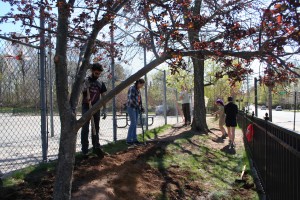
Common Ground Green Jobs Corps students lend a hand to community volunteers as they install the schoolyard habitat at Edgewood School.
Teachers report feeling more comfortable taking their classes outdoors and have used the habitat to do investigations on insects, observation of the plant lifecycle and studies on bird songs. The spaces are used for art projects, storytelling and math. Students create field guides and they quietly monitor migrating birds from behind strategically placed bird blinds.
And, the habitats bring people together. Hundreds of volunteers have planted native plants, spread mulch and constructed outdoor classrooms in schoolyard habitats since the program began in New Haven in 2013.
Representatives from Common Ground, Audubon CT, US Fish and Wildlife Service and the Peabody Museum support schools in the creation of their habitat as well as in curriculum integration and long-term management. Designing the outdoor classroom, planting all those native plants, teaching the first few lessons outside; all challenging first steps for each school. But the real work comes in sustaining the space, in truly embracing outdoor learning as part of the school culture so that each child can experience nature in their own school yard year after year.
Expanding the community
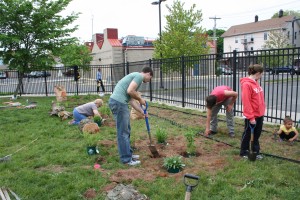 On Wednesday, October 14th, over 50 people will come together at Audubon Greenwich for the first Schoolyard Habitat Leadership Summit. Educators, school administrators, parents, community volunteers, naturalists and others will come together for a day of collaboration. We will share success stories and tackle common challenges. There will be panel discussions on fund raising and community engagement. David Sobel, a renowned education writer who focuses on outdoor play and place-based education, will give the keynote address and lead an engaging curriculum workshop.
On Wednesday, October 14th, over 50 people will come together at Audubon Greenwich for the first Schoolyard Habitat Leadership Summit. Educators, school administrators, parents, community volunteers, naturalists and others will come together for a day of collaboration. We will share success stories and tackle common challenges. There will be panel discussions on fund raising and community engagement. David Sobel, a renowned education writer who focuses on outdoor play and place-based education, will give the keynote address and lead an engaging curriculum workshop.
This summit is just one step in building a larger community around schoolyard habitats, bringing people together who share a common goal: conserving habitat for wildlife and facilitating the use of that space as an educational resource for school children.
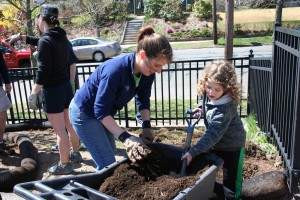 Next month, two additional New Haven public schools will join the Schoolyard Habitat Program and start the process of creating an outdoor learning space for students. The teams at each of these new schools will face the same challenges but they will also get the same reward: children learning outside in their own schoolyard, engaging with wildlife and becoming the next generation of environmental stewards in New Haven.
Next month, two additional New Haven public schools will join the Schoolyard Habitat Program and start the process of creating an outdoor learning space for students. The teams at each of these new schools will face the same challenges but they will also get the same reward: children learning outside in their own schoolyard, engaging with wildlife and becoming the next generation of environmental stewards in New Haven.

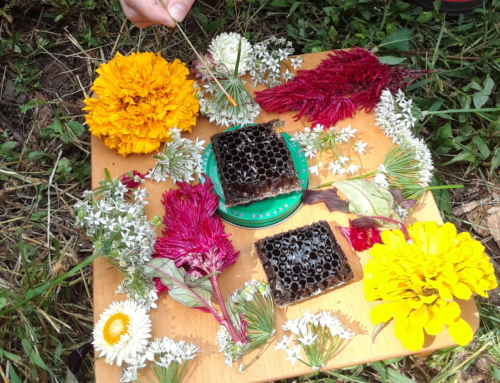


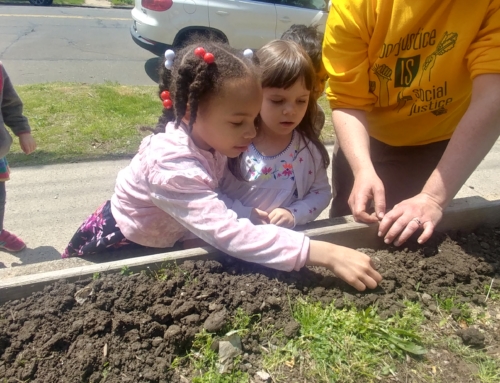

Leave A Comment